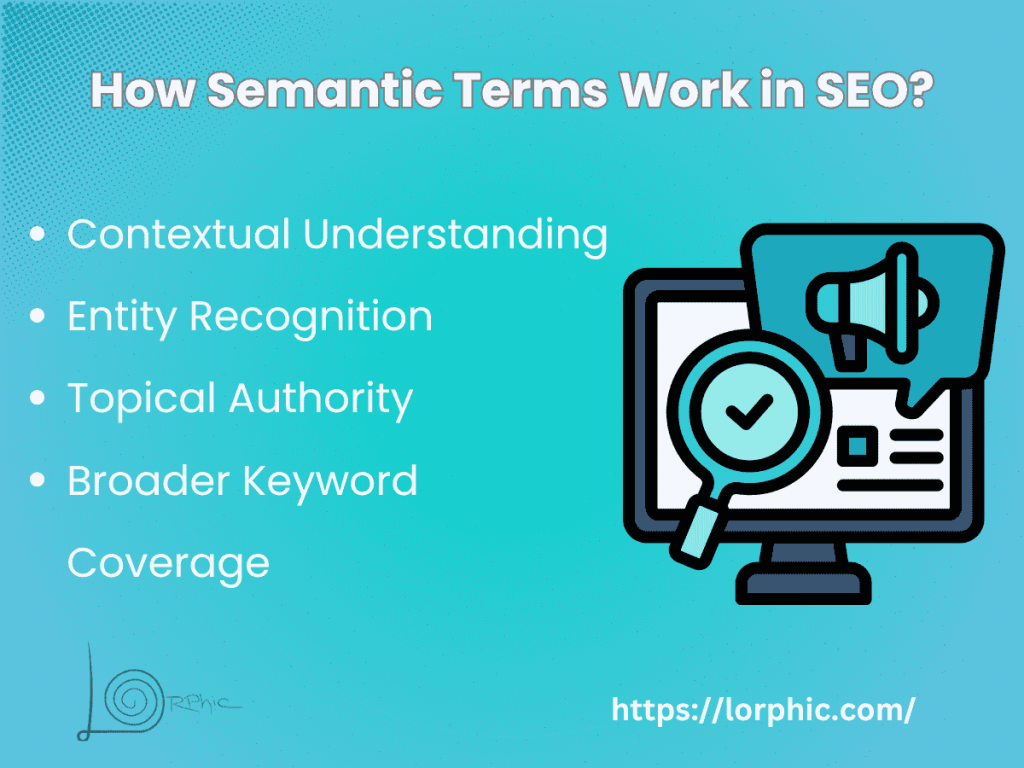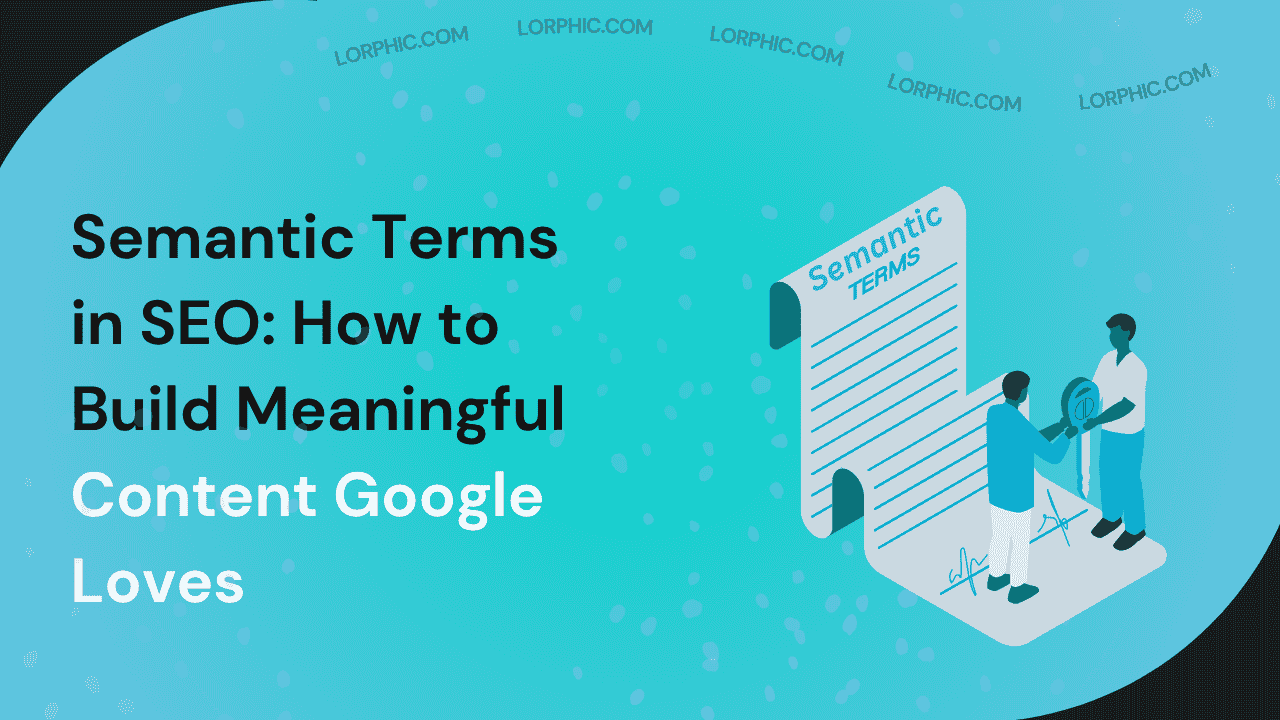In the world of SEO today, simply adding keywords to your content is no longer enough to rank well. Google’s AI-driven algorithms, such as BERT, MUM, and the Search Generative Experience, now prioritize understanding context, meaning, and user intent over exact keyword matches. This means that creating content that truly explains a topic and connects related ideas is more important than ever.
If you are curious about what are semantic terms in SEO and how they can improve your content, you are in the right place. By understanding and using semantic terms effectively, you can make your content more relevant, comprehensive, and valuable to both search engines and your audience.
What are Semantic Terms in SEO?
Semantic terms are words and phrases that help search engines understand the meaning and context of your content. Unlike traditional keywords, which focus on exact matches, semantic terms focus on concepts, related topics, and entities connected to your main subject.
For instance, if your main keyword is “digital marketing,” semantic terms might include SEO, social media marketing, PPC advertising, and content strategy. These related terms give Google a fuller picture of what your page is about, allowing it to rank for a wider range of relevant searches rather than just a single keyword.
Semantic terms matter because they improve the overall relevance of your content. By covering a topic more thoroughly, they help search engines recognize how concepts and entities relate to each other, which strengthens your authority on the subject.
Incorporating semantic terms into your content does more than just improve rankings. It also ensures your content genuinely meets user intent, providing helpful, informative answers that readers are looking for. This approach aligns perfectly with the goals of semantic SEO, making your content more meaningful and valuable.
How Semantic Terms Work in SEO?
Semantic terms help search engines understand the meaning and intent behind your content. Instead of relying solely on exact keywords, Google looks at the surrounding words, phrases, and entities to determine the full context of a page. In a case study by Dexora Digital, applying semantic SEO on a Shopify site over 35 days led to a 24 percent increase in ranking keywords and a 22 percent rise in organic monthly visits, highlighting how semantic optimization can deliver measurable results.

Contextual Understanding
Semantic terms provide critical context that helps Google understand the intended meaning of your content. Many words can have multiple interpretations, and semantic terms clarify which meaning you are targeting. For example, a page about “Apple” could refer to either the fruit or the technology company. By including related terms like iPhone, iOS, MacBook, or even Apple Store, Google can correctly interpret that your content is about the tech company. Similarly, for a post on “Java,” semantic terms like programming, software, or JDK clarify the context, preventing misinterpretation.
Entity Recognition
Entities are the core nouns in your content, people, places, brands, products, or abstract concepts. Using semantic terms allows Google to recognize and associate your page with the right entities. For instance, a blog about “Tesla” could mention Elon Musk, electric cars, Model S, or renewable energy, helping Google connect the content to the correct brand and related topics.
Topical Authority
Topical authority is established when your content thoroughly covers a subject and its related subtopics. Incorporating semantic terms and connected concepts helps you create a content cluster around a main topic, signaling expertise to Google. For example, an article on “content marketing” can include semantic terms like inbound marketing, SEO strategy, email campaigns, and social media content.
Broader Keyword Coverage
Semantic terms also help your content rank for multiple related search queries. For example, an article optimized for “content marketing strategy” could also appear for queries like inbound marketing tips, blog content strategy, or digital content planning. This wider coverage is a key benefit of using semantic terms in your SEO strategy.
How to Identify Semantic Terms?
Finding the right semantic terms is a crucial step in creating content that is meaningful, comprehensive, and aligned with search intent. Using the right terms helps search engines understand the depth and context of your content.
- Keyword and Topic Research: Start with your main keyword and explore related terms using tools like Google Autocomplete, People Also Ask, or keyword research platforms such as Semrush and Ahrefs. Tools like Surfer SEO can also provide NLP-driven term suggestions. These resources help you discover phrases that are commonly associated with your topic, giving you a strong list of semantic terms to include.
- Competitor Analysis: Look at the top-ranking pages for your target keyword to see which terms and concepts they emphasize. Pay attention to frequently mentioned phrases, related entities, and the subtopics they cover. This approach gives you a practical understanding of which semantic terms search engines value most.
- Entity-Based Approach: Focus on entities directly related to your topic. For example, if your content is about SEO tools, semantic terms could include Google Search Console, SEMrush, Ahrefs, and keyword analysis. Including these entity-based terms helps Google understand the scope and depth of your content.
- Natural Language Processing Tools: Advanced NLP tools, such as Google’s NLP API or MarketMuse, can identify semantic entities and relationships within content. Using these tools ensures your content covers all relevant terms, reinforcing topical authority and improving search visibility.
How to Use Semantic Terms in Content?
Once you have identified your semantic terms, the next step is to use them strategically. Incorporating these terms thoughtfully ensures your content is comprehensive, meaningful, and aligns with both user intent and search engine expectations.
Structure Content Around Topics
Organize your content to demonstrate expertise and authority on your subject. Start with a pillar page that covers your main topic and create supporting sections for related semantic terms. Include FAQs, definitions, and subtopics to expand on the main theme. This structure signals to Google that your content is well-organized and authoritative, helping search engines understand the relationships between different sections.
Context-Rich Writing
Focus on providing valuable context rather than just inserting keywords. Semantic terms should appear naturally within content that genuinely informs and engages readers. To do this effectively:
- Include examples, case studies, and real-life scenarios.
- Provide clear definitions and explanations of concepts.
- Make comparisons to related ideas or topics.
- Answer related questions your audience might have.
This approach aligns with how semantic SEO works in 2025, emphasizing depth, relevance, and usefulness over keyword frequency.
Internal Linking
Connect pages with semantically related content using natural anchor text. For instance, you can link to pages with phrases like “what are semantic terms in SEO,” “semantic SEO strategy,” or “importance of semantic keywords in SEO.” Effective internal linking helps Google navigate your site more easily and reinforces semantic relationships between pages.
Schema and Structured Data
Use structured data to give search engines more context about your content. Adding schema markup can improve your visibility in rich results and AI-generated summaries. Consider including:
- FAQ schema to highlight common questions and answers.
- How-to schema for step-by-step guides.
- Article schema for blog posts or informational pages.
Structured data makes your content easier for search engines to interpret and increases the chances of appearing in rich snippets, knowledge panels, and other enhanced search features.
Final Thoughts
Semantic terms are no longer optional in SEO, they are a fundamental part of modern content strategy.
Working with a semantic SEO expert or agency can help scale this process, ensuring your content aligns with the latest search algorithms and AI-driven search results. Incorporating semantic terms is also a critical part of semantic SEO in content marketing, as it ensures your audience receives meaningful, actionable, and relevant information.
As search engines continue to evolve, focusing on semantic relevance, context, and user intent will distinguish your content from the competition. By combining semantic terms with high-quality writing, structured data, and a well-planned internal linking strategy, you can position your website for sustained visibility, higher engagement, and long-term traffic growth.
FAQ’s
What are semantic terms in SEO?
Semantic terms are words and phrases that are contextually related to your main topic and help search engines understand the meaning and intent behind your content. Unlike traditional keywords that focus on exact matches, semantic terms capture relationships, entities, and concepts within your content, giving Google a clearer picture of what your page is really about.
How do semantic terms differ from keywords?
Keywords focus on specific phrases that users type into search engines, whereas semantic terms emphasize meaning and context. They cover related topics, concepts, and entities, allowing your content to address a broader range of queries. By using semantic terms, your content becomes more comprehensive and better aligned with user intent.
How can I identify semantic terms for my content?
There are several effective ways to find semantic terms. Start with keyword and topic research using tools like Google Autocomplete, Semrush, Surfer SEO, or MarketMuse. Look at top-ranking competitors to see which phrases and concepts they emphasize. Focus on identifying related entities and contextually relevant words that naturally complement your main topic.
Do semantic terms improve search rankings?
Yes, semantic terms can significantly boost your SEO performance. They make your content more relevant and easier for search engines to interpret, help clarify user intent, and establish topical authority. As a result, your pages have a better chance of ranking for multiple related queries and appearing in AI-generated search results or rich snippets.
Curated by Lorphic
Digital intelligence. Clarity. Truth.




